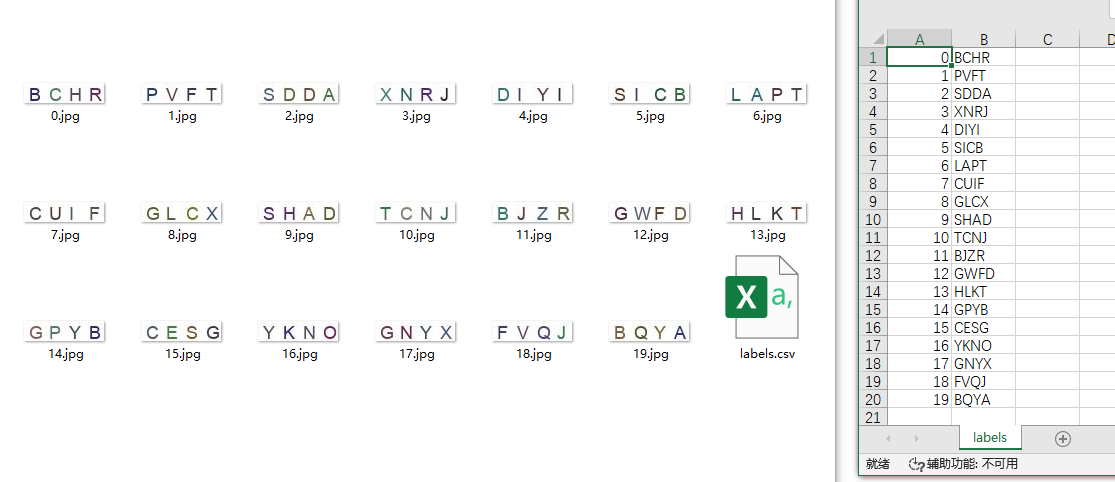数据来源:https://www.bilibili.com/video/BV1Wt411C75s?p=44&vd_source=5b26ae39f288c1978c47c005497bf0aa
数据格式
数据格式如下图所示,每张图片包含四个字母,labels.csv中存放着图片对应的标签。总共有6000张图片。

2.代码
2.1使用的库
import torch
from torch.utils.data import DataLoader
from torch import optim
from torch import nn
import numpy as np
import cv2 as cv
from torch.utils.data import Dataset2.2定义数据集
class myDataSet(Dataset):
'''
定义训练集
'''
def __init__(self):
#读入标签并转化onehot
labels = np.loadtxt('GenPics/labels.csv', delimiter=',', dtype=str)
self.labels = str2onehot(labels)
def __len__(self):
# 返回数据集长度
return len(self.labels)
def __getitem__(self, index):
label=self.labels[index]
label = torch.tensor(label)
#标签无法接收2维,所以将[4,26]的标签转化成[4*26]
label=label.reshape(4*26)
img=cv.imread('GenPics/'+str(index)+'.jpg',0)/255
img = torch.tensor(img)
#读取的img图像为灰度图,是[20,80]的,需要变成[1,20,80]
img = torch.unsqueeze(img, 0)
img=img.to(torch.float32)
return img,label
class myDataSet_test(Dataset):
'''
定义测试集
'''
def __init__(self):
#读取标签
labels = np.loadtxt('GenPics_test/labels.csv', delimiter=',', dtype=str)
self.labels = labels[:,1]
def __len__(self):
# 返回数据集长度
return len(self.labels)
def __getitem__(self, index):
label=self.labels[index]
data=cv.imread('GenPics_test/'+str(index)+'.jpg',0)/255
data = torch.tensor(data)
data = torch.unsqueeze(data, 0)
data=data.to(torch.float32)
return data,label3.网络模型
class Lenet5(nn.Module):
def __init__(self):
super(Lenet5, self).__init__()
self.conv_unit = nn.Sequential(
# 输入大小为:[batchsize,1,20,80]
nn.Conv2d(1, 6, kernel_size=3, stride=1, padding=0),
nn.MaxPool2d(kernel_size=2, stride=2, padding=0),
nn.Conv2d(6, 16, kernel_size=3, stride=1, padding=0),
nn.MaxPool2d(kernel_size=2, stride=2, padding=0),
)
self.fc_unit = nn.Sequential(
#将上面的卷积层展平后是864
nn.Linear(864, 120),
nn.ReLU(),
nn.Linear(120, 240),
nn.ReLU(),
nn.Linear(240, 104)
)
def forward(self, x):
'''
:param x:[b,ch,h,w]
:return:
'''
batchsz = x.size(0)
# 卷积层
x = self.conv_unit(x)
# 展平的函数
x = x.view(batchsz, 864)
# 全连接层
logits = self.fc_unit(x)
return logits4.训练
def train():
'''
训练模型
:return:
'''
train_dataset = myDataSet()
train_iter = DataLoader(train_dataset, batch_size=32, shuffle=True)
device = torch.device('cuda')
model = Lenet5().to(device)
# 损失函数用这个,可以对标签分类使用
criteon = nn.MultiLabelSoftMarginLoss().to(device)
# 优化器
optipizer = optim.Adam(model.parameters(), lr=1e-3)
for epoch in range(20):
#做训练
model.train()
for x, label in train_iter:
x, label = x.to(device), label.to(device)
logits = model(x)
loss = criteon(logits, label)
#每次进行反向传播的时候先把他清零,他不会自动清零,不清零的话这个值会一直叠加
optipizer.zero_grad()
loss.backward()
optipizer.step()
#做测试,用eval可以防止对训练的参数造成干扰
model.eval()
with torch.no_grad():
total_correct = 0
total_num = 0
for x, label in train_iter:
x, label = x.to(device), label.to(device)
logits = model(x)
# 变成[4,26]后对每行求最大值,相当于对四个位置分别求其对应的字母
logits = logits.reshape([-1, 4, 26])
pred = logits.argmax(dim=2)
label = label.reshape([-1, 4, 26])
label = label.argmax(dim=2)
#比较正确率
total_correct += (torch.eq(pred, label).float().sum().item())/4
total_num += x.size(0)
acc = total_correct / total_num
print(f'第{epoch}轮后的loss为{loss},acc为{acc}')
torch.save(model.state_dict(), 'model_parameter.pkl')5.测试
def test():
'''
测试模型
:return:
'''
test_dataset=myDataSet_test()
test_iter = DataLoader(test_dataset, batch_size=1, shuffle=False)
device = torch.device('cpu')
model = Lenet5().to(device)
model.load_state_dict(torch.load("model_parameter.pkl")) # 加载模型参数
model.eval()
for x, label in test_iter:
x= x.to(device)
logits = model(x)
logits = logits.reshape([4, 26])
pred = logits.argmax(dim=1)
pred=pred.numpy().tolist()
str_pred= ''
for i in pred:
str_pred= str_pred + chr(ord('A') + i)
label=str(label[0])
print(f'实际值是{label},预测值是{str_pred},',end='')
if label==str_pred:
print('预测准确')
else:
print('预测错误')3.小结
算是第一个自己完成的深度学习模型,虽然也是在教学视频案例的基础上缝缝补补,但是自己过一遍下来收货不小。
感觉这个模型中还有挺多疑惑的地方,比如读取图片那里,不知道是这样用一次读一次合适,还是先把所有图片都读进来,然后直接用合适;另外还有关于onehot编码的地方,看教程说pytorch可以自动转换,但是对于这种多标签的分类的话他能按照想要的那种方式转换吗,他每一张图片都有4个字母也就是4个标签。
总之先把这个代码记录下来,后面再慢慢学慢慢改

























 被折叠的 条评论
为什么被折叠?
被折叠的 条评论
为什么被折叠?








